The 16th-century Chinese novel Fengshen Yanyi tells the story of Nezha, a child deity who can’t quite keep from killing people. First, he nearly kills his mother, who carries him in utero for four agonizing years before birthing “a huge meatball” that rolls around “in mad circles like a wheel.” As a boy, Nezha kills a series of important people with his toys, which he keeps forgetting are lethal weapons, and to avoid retribution against his family, he disembowels himself, absolving them of responsibility. After Nezha's death, his father burns down a temple built in his honor, calling him “impudent,” a troublemaker. This enrages Nezha’s spirit, who beseeches his master, Superiorman Paragon, for help. Superiorman Paragon obliges, crafting Nezha a new body out of lotus flowers and bestowing a gift: two “wind-fire wheels," aboard which Nezha sets out to seek revenge.
The Chinese have lots of names for hoverboards, which are all made here, mostly in the vast southern province of Guangdong: They call them huaban, “skateboard,” or pinghengche, “balancing wheels,” or diandongpinghengban, “power balance board.” But people in the know, young people on the internet, cool people, call those goofy two-wheeled scooter thingies feng huo lun or fung fo leon: wind-fire wheels. The name doesn’t just describe the board; it also describes the rider: someone young, someone who likes to show off, someone who is maybe a little bit of a punk.
Also, someone incurious. Nezha doesn’t wonder where Superiorman Paragon actually got the nifty wheels — he just uses them. They’re just there.
And so, almost overnight, are hoverboards. They’re in MTV awards shows and Justin Bieber videos; in suburban high schools and on city sidewalks. They’re a physical commodity, but they’re also a meme — popularized by celebrities, shared endlessly on Twitter and Instagram and Vine, discussed to death by the chittering idea factory that is the English-language internet. Wiz Khalifa’s tweet calling the boards “the technology everyone will be using in the next 6 months” has been retweeted some 34,000 times; when Kendall Jenner posted a video of herself flailing around on a model called the PhunkeeDuck this summer, more than 1.1 million Instagram accounts liked it. According to Alyssa Steele, divisional merchandising manager at eBay, the site currently has about 10,000 listings for hoverboards; in the first two weeks of November, one was being sold there about once every two minutes. Over the past week and a half, that number has ramped up to one board every single minute of the day. Hoverboards are clearly, loudly, definitely here — but still, most Americans have only the faintest idea about where they actually come from.

That place is, more likely than not, Shenzhen, a former fishing village in southern China that, in 1979, became the country's first “Special Economic Zone,” in which corporations from around the world could operate unencumbered by prohibitive Communist business restrictions. Between then and 2014, its population grew from 30,000 to 15 million, nearly twice the size of New York City.
Today, Shenzhen is a rambling, smog-browned kingdom devoted to the production of electronics. It and the other great manufacturing cities of China's Pearl River Delta — an industrial megalopolis home to about 80 million people — are the only places in the world that are truly equipped to build the amusements of our contemporary culture almost as soon as we name them. They offer people (on the cheap), plenty of space, and a network of closely aligned, one-stop-shop parts suppliers: a combination known in the manufacturing world as a “turnkey solution.” Shenzhen is where Apple infamously contracts with Foxconn to make many of its electronics, and where many of China’s high-tech firms make all manner of things for you to plug in. It’s where most of the gadgets in your home come from, and where most of the ones in your office come from, too.
Shenzhen is also, and only very recently, the hoverboard manufacturing capital of the world. In the smoke and asphalt of Bao An, a sprawling industrial flatland roughly the size of Philadelphia that serves as one of the city’s main manufacturing districts, hundreds of factories churn out much of the world’s supply of the boards, which are then shipped, rebranded, and sold around the globe.
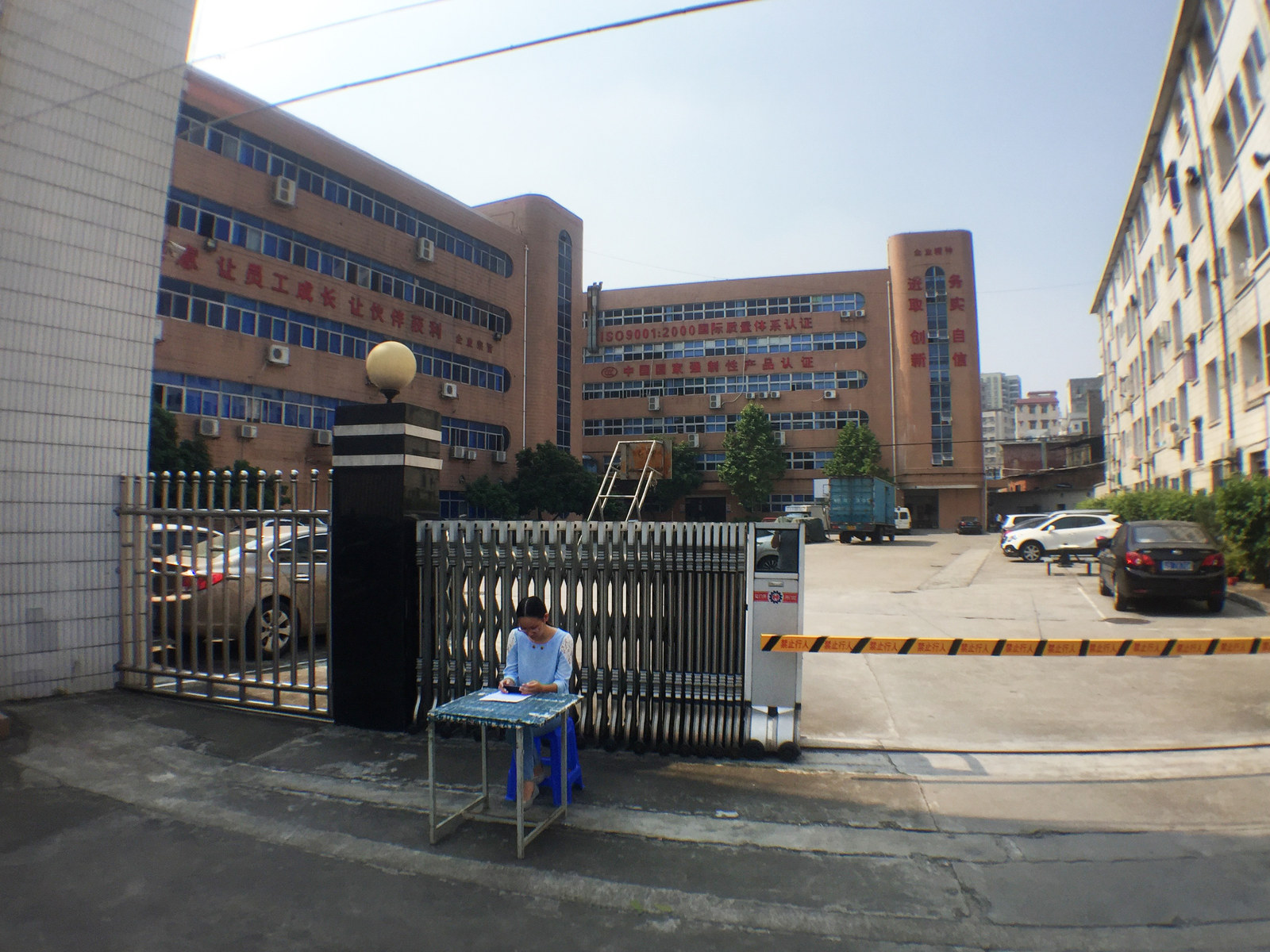
One of those factories is Gaoke (or “High Tech”) Times, a midsize plant situated on 120,000 square feet in a Bao An industrial park. The facility’s brown concrete walls have been decorated in 5-foot-high, bright red metal characters announcing corporate slogans. “WE LET OUR CUSTOMERS BE SATISFIED, OUR EMPLOYEES GROW, AND OUR PARTNERS MAKE PROFIT,” reads one, in Chinese. “BE: AGGRESSIVE. REALISTIC. CONFIDENT,” reads another. Inside, 60 employees — about a 10th of the company’s workforce, most of whom live in a ramshackle dormitory next to the factory — churn out 600 boards in a day, for customers in the U.S., U.K., Dubai, and Australia.
Nearby, a bustling street hums with small restaurants and shops catering to Gaoke’s employees; above them rise identical two-story gray cement apartment blocks, balconies draped with laundry. Across from the the factory’s security gate, a small store stocks discontinued Gaoke products — televisions, rice cookers, English-language instruction cassette tapes — still in their original shrink-wrapping, to be sold at a discount to the factory’s workers. According to the shopkeeper, they’re a captive market and an easy way for Gaoke to get rid of dead stock.
On an October morning, in a suite of corporate offices on the top floor of one of Gaoke’s factory buildings, Fang Zuoyi, the company’s fortysomething general manager, sat unwrapping a pack of cigarettes. Fang’s office was littered with spare parts; empty hoverboard boxes; and a promotional poster board mock-up depicting one of Gaoke’s boards, superimposed enormously on top of an image of the factory. Two flights below, the oily smelling production floor was empty; it was noon and the workers were at lunch. But their labor was everywhere. Boxes stamped “Kaiser Baas,” an Australian distributor that markets Gaoke’s boards as “Revo Gliders,” lay neatly stacked next to finished boards wrapped in loose plastic and stored vertically, sorted by color. On a table sat a nearly finished board missing only the top half of its plastic case. In the research and development department, the young engineers tasked with breaking down existing products and figuring out how to rebuild them sat, feet propped up on their desks, surrounded by disemboweled scooters.
In the two decades Gaoke has been here in Shenzhen, it has made desktop phones, then DVD players, televisions, mobile devices, and eventually tablets, which today are the largest part of its business. Hoverboards, Fang explained over strong tea boiled on a desktop hot plate, were new. About six months ago, at the request of some of the company’s existing tablet customers, Gaoke had started manufacturing them. New product crazes present struggling businesses and eager entrepreneurs alike with an opportunity to leave behind glutted markets, and the nature of China’s booming electronics business is to be adaptable to the whims of a global market. “Whenever there is a popular product,” Fang said, “everyone gets involved.”
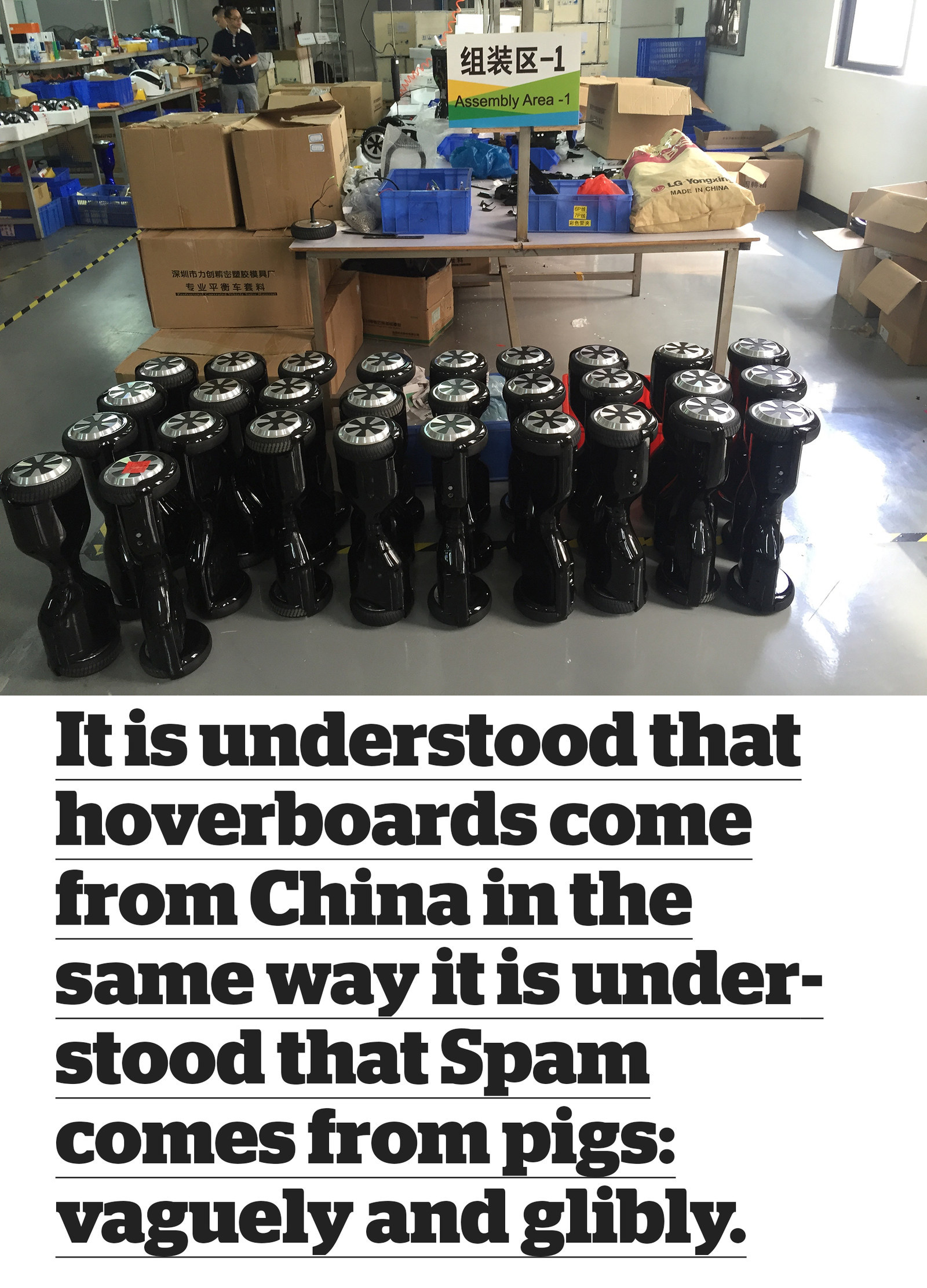
It is understood that hoverboards come from China in the same way it is understood that Spam comes from pigs: vaguely and glibly. Among those who made them popular — me and you and Skrillex and that guy your dad saw at Starbucks last month — the prevailing notion seems to be that they all roll off the same assembly line somewhere in the developing world. But the truth is that China’s hoverboard industry is already breathtakingly large and absolutely flooded. And it was built essentially from scratch, as so many Chinese novelty industries are. While the Western internet was still quibbling about what to call the damn things, a massive industrial organism was shuddering into place halfway across the world; today, Fang Zuoyi estimated that there are at least 1,000 factories in the Shenzhen area making hoverboards. If he’s right, that’s more than two new factories a day since the release of the Chic Smart, thought to be the first mass-market hoverboard.
But whether or not it stays this way — whether hoverboards end up underneath every Christmas tree in America or on the shelves of the Gaoke company store, discounted for the people who made them — depends on the persistence of the capricious global consumer market, fomented by social media, which over the past six months has anointed these gliding hunks of metal and plastic its objet du jour and accepted their rapid appearance more or less unquestioningly, even though the facts around them are totally bizarre. You can’t generally buy them in brick-and-mortar stores, only off sketchy-looking Shopify sites that sometimes list fake physical addresses, or out of trucks in big cities, or in barely regulated mall kiosks. Big chains can’t even decide whether to sell them online. The price spread of the boards makes no sense: Some of them are $1,800 and some of them are $300, but they all look the same.
It’s as if the boards have come here faster than the places that should be selling them can handle. This is not a coincidence. The hoverboard industry that has unfurled in the concrete of Bao An and other similar districts is on-demand IRL content production, a super-flexible churn that hands us the playthings of social-media-driven seasonal diversion. It is the funhouse mirror reflection of the viral internet, the metal-and-cement consequence of our equally flexible commercial hype machine. It happened before with selfie sticks, and before that with drones. It may soon happen with virtual reality headsets and body-worn police cameras. It happens all the time.
Call it memeufacturing. It starts when a (typically) Western company, eager to cash in on a product made popular by the social internet, contracts a Chinese factory to make it. From here, the idea spreads throughout the elaborate social networks of Chinese electronics manufacturing until the item in question is being produced by hundreds and hundreds of competitors, who subcontract and sell components to each other, even as they all make the same thing. It reaches its saturation point quickly. It moves from product to product without sentiment. And it is proof that our never-ending digital output, our tweets and Vines and Instagrams and Facebook posts, has the power to shape the lives of people on the other side of the world.
Hoverboards could stay wildly popular, and Gaoke could remain a hoverboard factory. Or they could go away, and it could become something else. It all depends on the whims of people on the other side of the planet.
“When we see a demand, we change our business direction,” Fang said, simply. “It is about survival.”
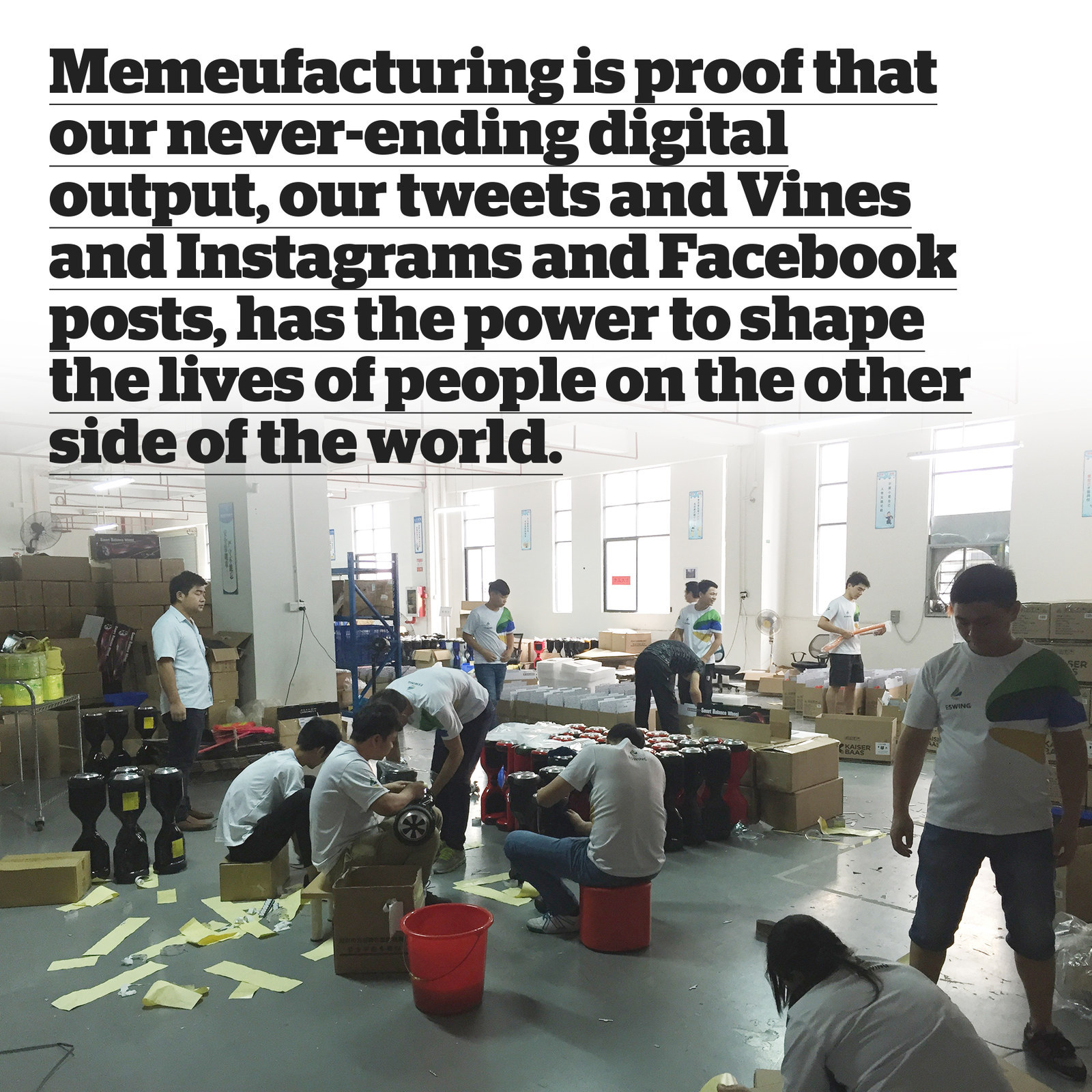
In October, nearly 4,000 exhibitors gathered at a 1 million-square-foot convention center jutting into Hong Kong’s Victoria Harbor. They were here to meet some of the people looking to buy and resell fung fo leon, hoverboards, self-balancing two-wheel scooters, power balance boards, whatever you wanted to call them. As long as you were interested in buying them, it didn’t matter. As long as you were interested in buying something.
On the ground floor of the convention center, a 22-year-old named Natalie Cheung stood handing out fliers, a hoverboard idling next to her feet; she told me she was getting paid 45 Hong Kong dollars (about $5.80 USD) per day to point people in the direction of “featured products,” which included heart-rate-sensing earbuds, a drone the size of a small flapjack, and a “2-wheel Electric Scooter” with “ultra endurance” and “refined aesthetic.” On floor after floor, cavernous halls housed thousands of identical metal and plastic booths, each one representing a factory, most of them on the Chinese mainland. Together, they offered everything imaginable that can be plugged in, from televisions and tablets to alarm systems and electronic toothbrushes; hair dryers and flashlights to megaphones and industrial relays; UV disinfectors and toasters to underwater cameras and digital Bible readers.
Though the fair was a huge production, it is probably more useful to think of it not as one discrete event, but as a single destination in a rolling regional spectacular. A week after the Hong Kong show, many of the exhibitors would pack up and head to Canton Fair in Guanzhou, an extravaganza so intense the powers that be divided it into six separate “phases.” After that, they’d move on again: Chinaexhibition.com lists 25 electronics fairs in China and Hong Kong between now and September 2016.
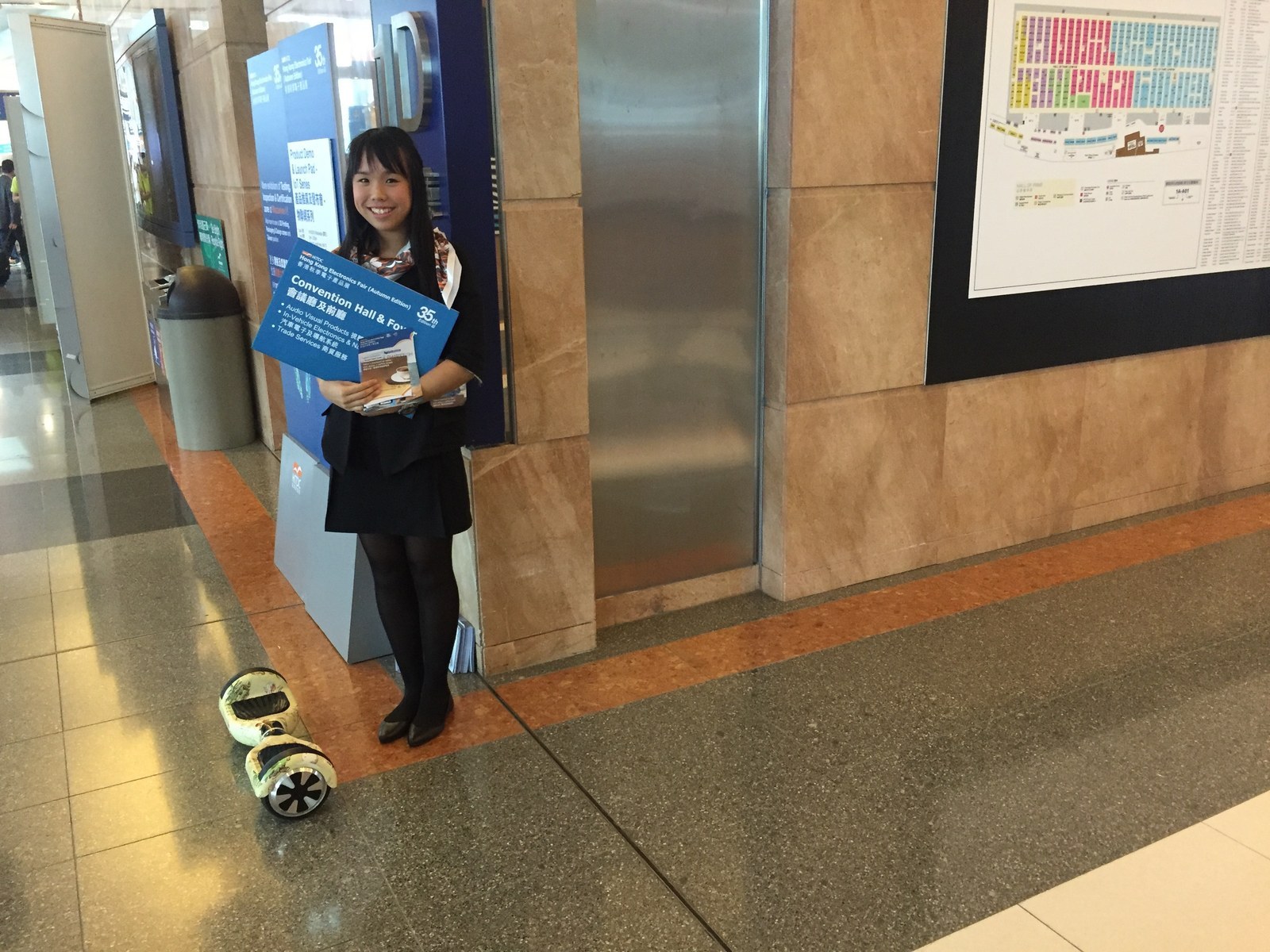
At least 30 hoverboard manufacturers had paid for booths at the show, most of them clustered together in a maroon-carpeted hall the size of a football field. Each was staffed by three to six uniformed and smiling salespeople, standing ready to approach idling customers with pamphlets neatly stapled to business cards, delivered with two hands, the way you set down a tray in a cafeteria. Each was here to convince potential buyers that its product was different from the dozens of others in the same room, which its salespeople did via a set of stock responses: That they had superior quality control (a claim that was impossible to verify on the spot, and likely difficult to verify at the factory), or that they manufactured key components in-house, or that their batteries were better (a claim that was also fuzzy: With a few minor exceptions, the factories all used replaceable components, meaning any customer with the money could shell out for nice batteries).
And none were particularly shy about the fact that their factory may have, as recently as days before, made something entirely different: e-cigarettes, DVD players, Bluetooth speakers, earbuds, drones. One factory, Gamtec, was so new to making hoverboards that its staff hadn’t had time to fit pictures of the board into its most recent catalog. They had printed a supplement.
Most of the hoverboard factories at the show began making the boards because they received a request from a distributor with which they had a previous relationship. Or at least they claimed to; others almost certainly started making boards when they learned of other factories converting to hoverboards, though they would never admit it.
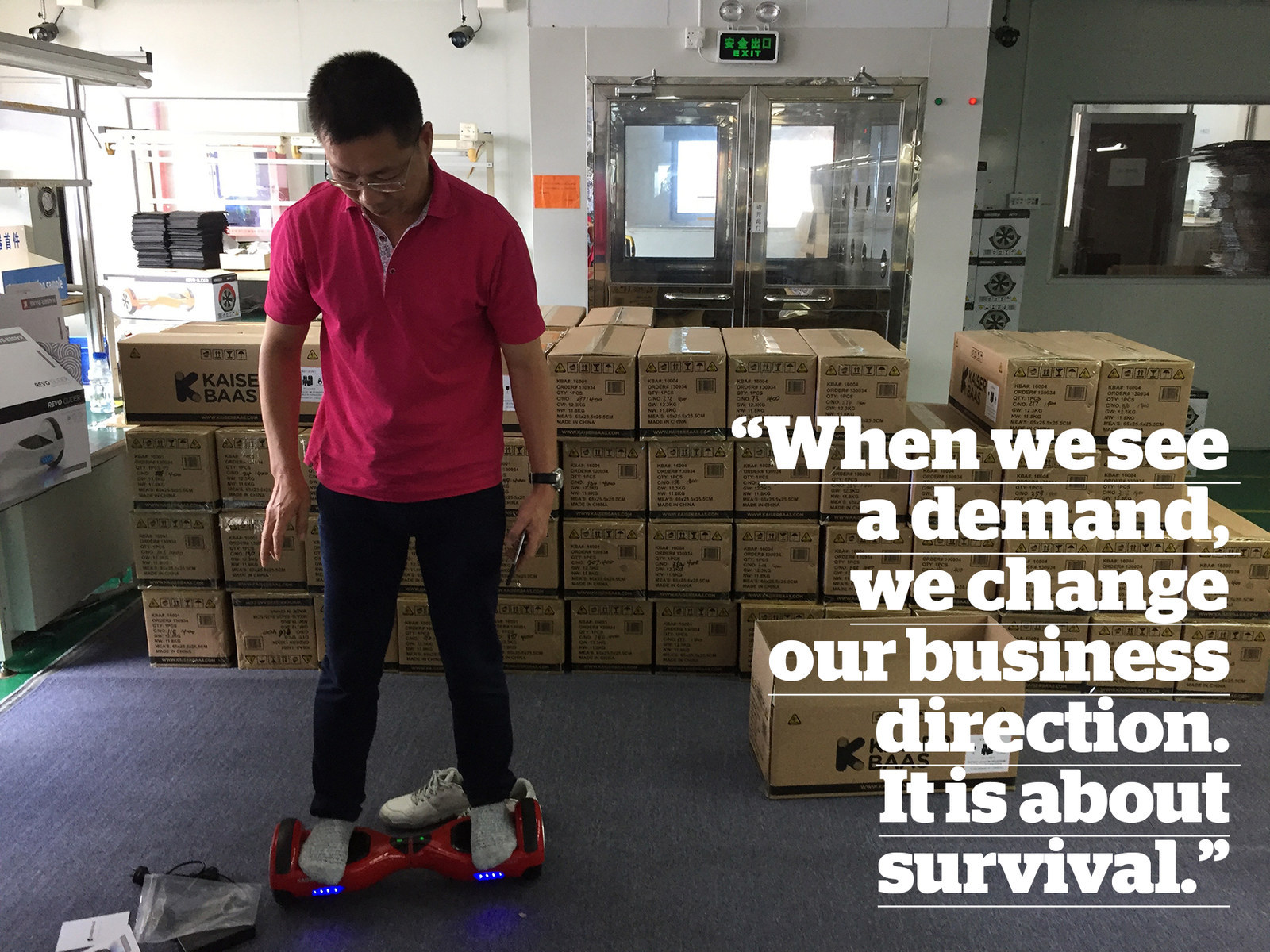
To a person, the salespeople said that their companies started making hoverboards because they were “the new hot product” or “the new big seller.” “Last year the selfie stick was very popular,” said a young woman named Rachel Yu, who, along with several other salespeople from the 3-year-old Ocam Electronic factory, had made the two-hour journey from Shenzhen to Hong Kong to find new business for its hoverboard, the Esway. “But we need to change with the market or we’ll die.”
Now selfie sticks don’t even appear on the Ocam website, and the company has gone all-in on hoverboards. Ocam offers the boards in two makes that cost between $250 and $760 per piece, according to specifications. The factory can make about 5,000 of them a month, Yu said.
Ocam’s business is selling to distributors — evenly split between the U.S., Europe, and the Middle East, Yu said — that resell a factory’s product and “add the value” of their name and branding. A distributor could be a well-branded Shopify site, but it could also be an enormous retailer. A salesperson for Kungfuren, a Dongguan factory that makes selfie sticks for Wal-Mart, said her company was in discussions with America’s largest business to sell hoverboards to it through an importer.
In a sense, the purpose of booths wasn’t to show that a factory had a long, proud history of making hoverboards. Rather, it was to show that a factory was flexible enough to build the boards in any conceivable configuration of colors and components, to the exact specifications of the buyer.
Those buyers skewed toward countries where hoverboards hadn’t yet hit it big, or where intellectual property litigation — who actually owns the patent on hoverboards in several countries is still very much up in the air — didn’t threaten sales. Two suited Turkish business partners who claimed to have invented an electric car thought they could crack the hoverboard market at home. An Italian cell phone accessories salesperson with a mop of ink-black ringlets thought he would sell some for the holidays. A Saudi importer joked that hoverboards were so popular in his country because everyone had money and nothing to spend it on.
And an American salesperson named Ryan Knott had been sent on behalf of his firm, SGH Holdings, to decide whether to invest heavily in hoverboards or not. The company had sold something called CoolSculpting, a form of “non-surgical fat reduction treatment,” but decided to switch course. Knott, who wore shiny loafers and a dynamite tan, had decided to get into the business 45 days before. At the show, Knott was worried about the market becoming oversaturated, and the dozens of identical manufacturers weren’t doing anything to help.
“They all throw the same thing at you,” he said. “They’re really all the same.”
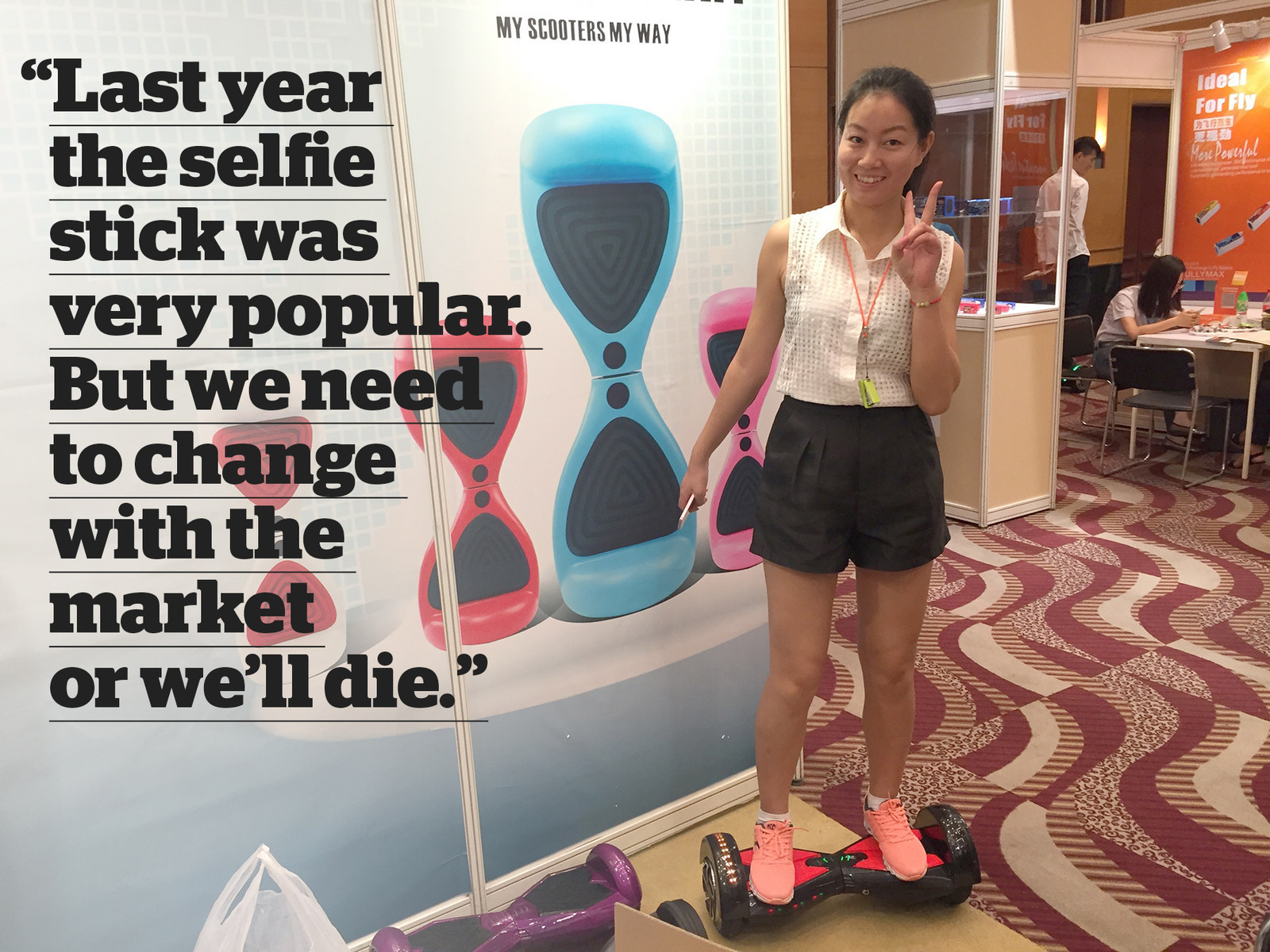
Among the dozens of same-seeming factories, there was an original design manufacturer, a company that creates and owns intellectual property: Chic Robotics. Chic holds contested Chinese patents on hoverboard design, and the company had by far the most professional presence at the show, with the sleekest uniforms and the slickest materials. Unlike the other hoverboard factories, which were all located in the Pearl River Delta, and largely in Shenzhen, Chic was from Hangzhou, outside Shanghai. (In addition to its own “Chic Smart” scooter, Chic manufactures IO Hawk, the American board that is currently entangled in patent litigation.) Under the direction of Chic’s sales manager, Simon Wang, the company had filed requests with the Hong Kong Trade and Development Council to remove the other hoverboard companies from the show. Another Chic employee showed off copies of paperwork.
And yet, no salespeople at any of the other hoverboard booths reported having been notified of Chic’s action by fair representatives, and some reacted with surprise upon hearing the accusation.
“OMG! We copied their board?” a salesperson named Mary Han from Lambert Technology Co. Ltd. asked incredulously, while also grinning. “Our board is original. They copied us! OMG!”
Even if Chic could have shut down the other companies, it seemed a largely futile task, like quarantining a handful of patients long after a virus had spread. Simon Wang explained that his staff would have to go through the same rigamarole at the next big fair. And while the fair officials said all the right things about the sanctity of copyright, they had also put a knockoff board at the feet of Natalie Cheung.
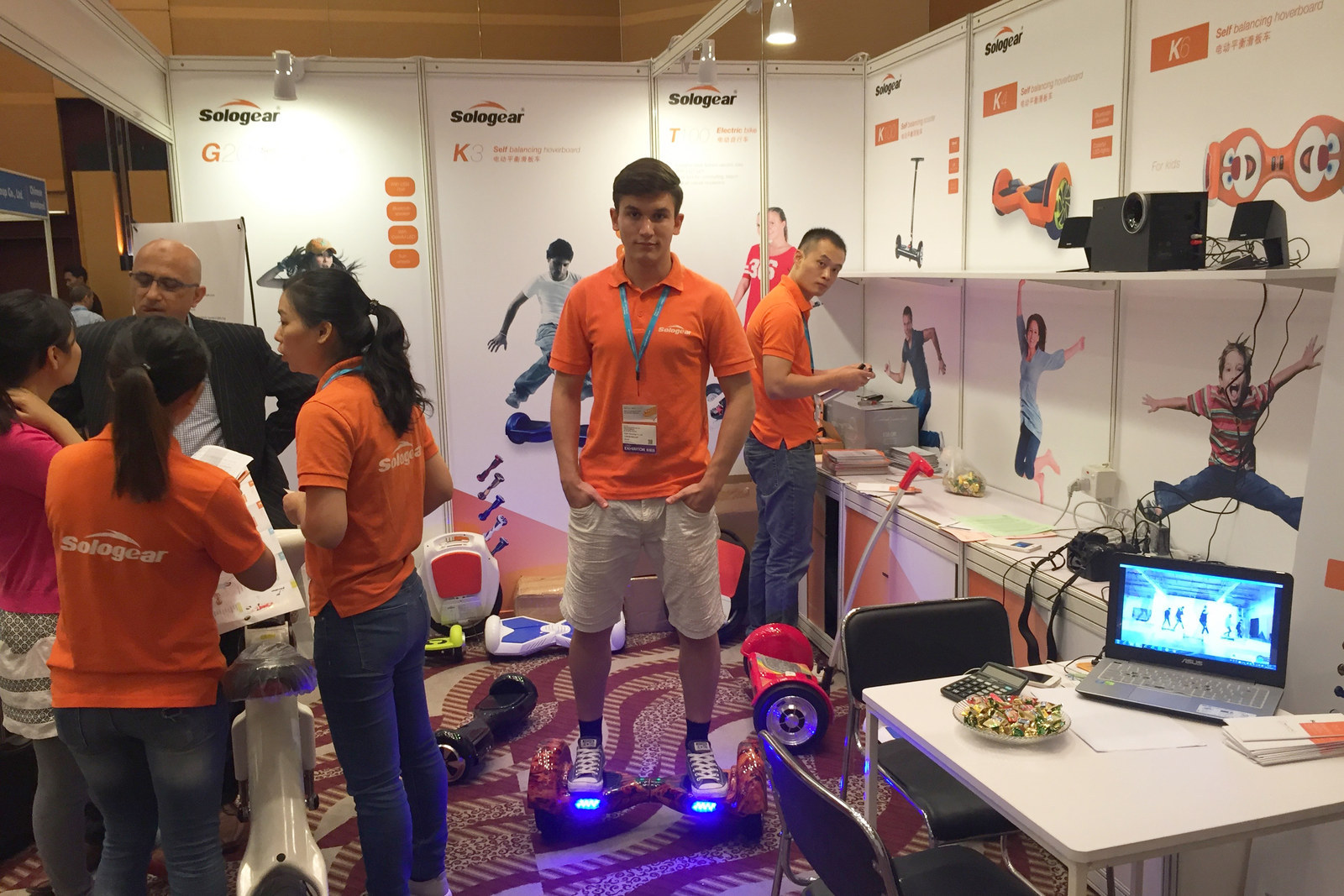
Among the uniformed and smiling salespeople, a single face stood out: that of Antony Theodor, the 19-year-old son of an Athenian importer-exporter. Theodor had decided to attend Shenzhen University, partially to gain practical experience in China and partially to escape financial doom in his home country. While accompanying his father to the spring edition of this trade show, Theodor had jumped aboard a self-balancing unicycle, another popular scooter made by Sologear. When company reps saw a handsome European teenager, one they discovered could speak Mandarin, zipping around the show on their product, they offered him spot work immediately. On the inside flap of a glossy brochure, he sat smiling and holding a scooter. Inside were another five photogenic white people, also using Sologear products. Theodor wasn’t sure how the company had found the other models, just that they were also white people who likely lived in Shenzhen.
Not only did Theodor work part-time for Sologear, he would represent another factory at Canton Fair later that month. He didn’t think his superiors at either company would care. Theodor was also fairly sanguine about the profusion of new hoverboard companies. True, the market was now flooded. But soon the manufacturers with staying power would emerge, and everyone else would sell their stock to the winners and move on to something else.
“Hey, this is China,” he said, and shrugged.
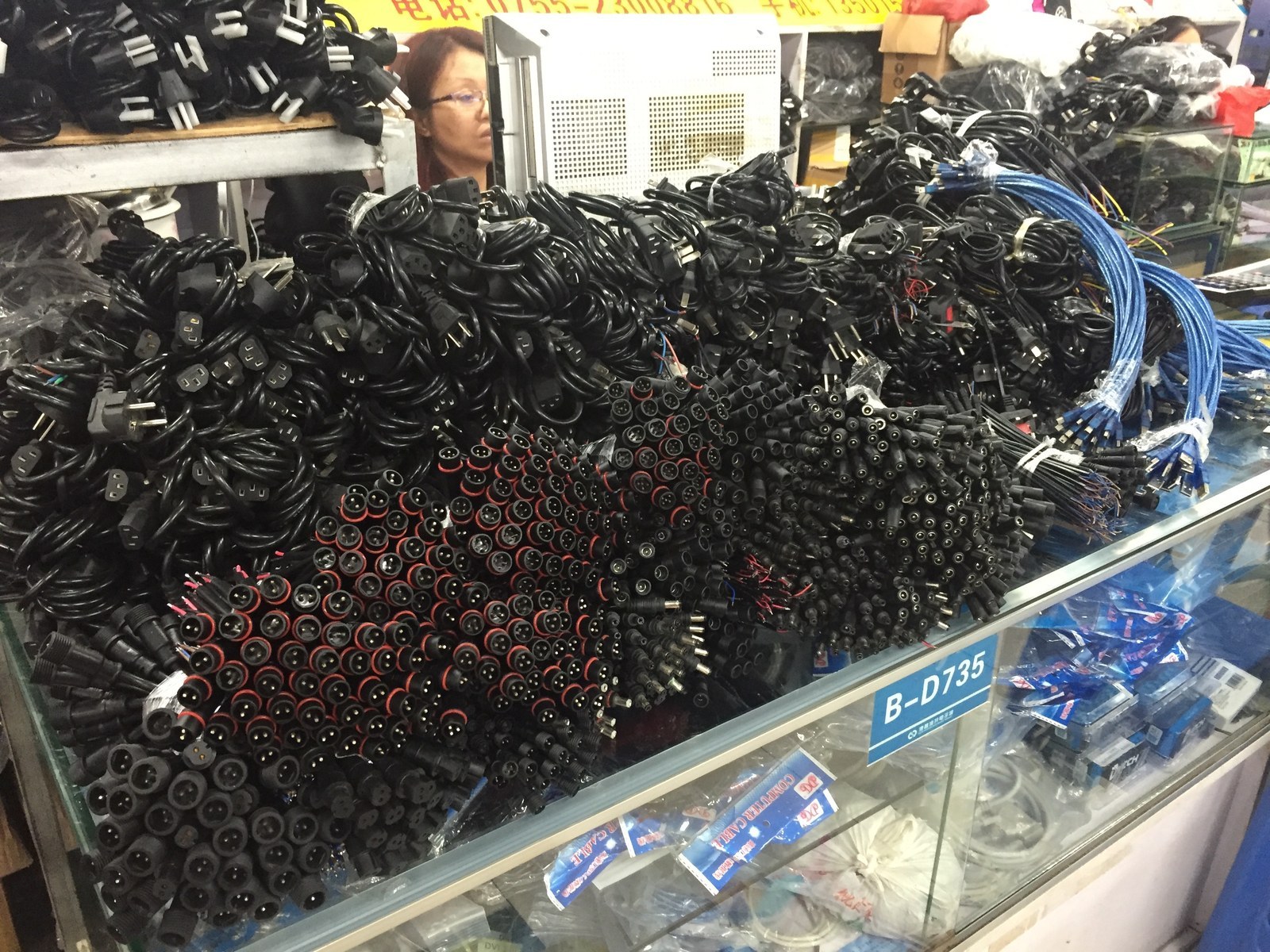
Every year, hundreds of thousands of people migrate to Shenzhen from provinces around China. The city isn’t growing as fast as it was in the '80s, '90s, and '00s, but it’s still heaving with newcomers: migrants coming from farm villages, university graduates looking for white-collar work, would-be tycoons angling to corner the market on the next big product. All of them are bound by the fact that their work depends on the consumer demand of the rest of the world.
Zhou Changbo is one of them. Zhou has an impressive title — CEO — but the day after the Hong Kong Electronics Fair, he was dressed in a fake Versace T-shirt, shorts, and sandals, and he explained that his position was far from glamorous. Until earlier this year, Zhou worked for a big company in Shandong province, 1,100 miles to the north. That company, Wantong Technology, sold circuit boards to scooter factories, and as business heated up late in 2014 and early in 2015, some of Wantong’s clients in Shenzhen started clamoring for after-sale service, while others wanted Wantong to sell them the entire assembled hoverboard itself.
So in June, Wantong sent Zhou south to start a hoverboard company. Kaibin Fly, also Cool Fly Ltd., quickly hired 12 locals: 10 laborers and two office workers. The company rented a floor in a rundown factory near an enormous YKK Zipper plant. From its tiny facility — two squat toilets, stacked boxes labeled “Swagway,” an empty block of six cubicles hopefully titled “Sales Dept.” — Zhou had set up a single production line. The company already had enough work that it couldn’t hold on to its inventory.
Cool Fly mostly sells to other Chinese hoverboard factories, but also directly to Swagway, one of the best-known distributors in America. You could pretty easily trace the path from Wiz Khalifa’s feet, to the flurry of social media activity, to the interest of Western distributors, to the deals with Chinese factories, to Zhou moving to Shenzhen. Setting up the factory had been an exhausting process, he said, but one thing he had no trouble with was finding parts for his boards. “That is the the beauty of Shenzhen,” he said.
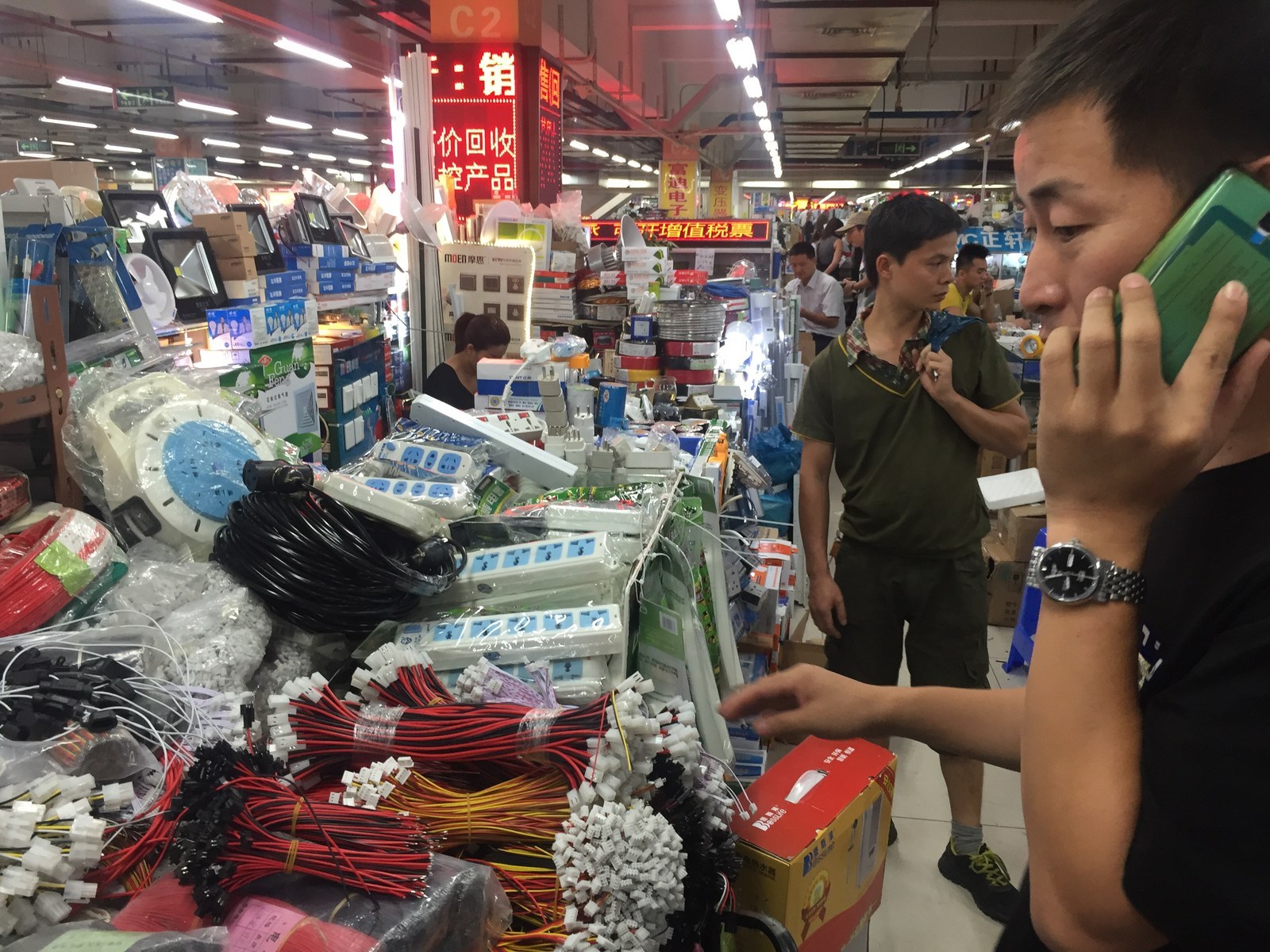
On a humid afternoon, Zhou went shopping for some of those very parts at a Bao An market. As he pulled his maroon minivan into a crowded parking lot, the full scale of Depu Electronics came into view: a three-story concrete behemoth roughly bigger than a Costco and roughly smaller than the Pentagon. Inside, it looked like the world’s largest Radio Shack going out of business sale: an endless series of booths with cables and circuit boards and plugs and ports and buttons and machines piled so high on tables that the faces of the clerks who were selling them were hidden from view. Each booth seemed to argue: We have exactly what you want and we have enough of it for all of your customers. Short of motorized wheels and molding, the market offered nearly everything an ambitious factory owner would need to build a hoverboard, just waiting to be bought, assembled, and shipped.
Zhou browsed the stalls with his phone pressed close to his ear. After about 20 minutes, he left: He had forgotten his shopping list at the office and couldn’t remember what he came for. On the way back, he stopped by the molding plant where his workers stamp sheet metal into hoverboard frames. In an acrid-smelling room, a gaunt worker sat bent over a 2-foot-tall bamboo pipe, which he held with work gloves the size of Mickey Mouse hands. A few feet away, three enormous canvas sacks brimming with metal waste slouched against a wall. Zhou picked a piece of metal out of one of the sacks, turned it over, and snapped it in half. Soon enough, he was back in the minivan, on his way to the Cool Fly factory.
From the driver’s seat, Zhou explained that all of the components and labor added up to a cost of between 800 and 900 yuan ($125 to $140) for each board. He sold the boards to traders and other manufacturers for about 1,000 yuan a board, meaning he made a profit of 100 yuan, or about $16, on each one. Zhou wasn’t in financial trouble; he had the backing of a big company up north. But he still bemoaned the fact that most of the profit was being made by traders, who marked the boards up massively in foreign markets.
When Zhou learned the comparatively high cost of the boards in America — the IO Hawk goes for more than $1,000 — he made a noise halfway between a laugh and a groan: amused disgust. He would have to sell dozens of boards to make that much money. Even though Western distributors needed companies like Zhou’s to meet demand, the proliferation of companies like Zhou’s meant that he would never be able to set prices at a level where he would be compensated fairly by Western standards.
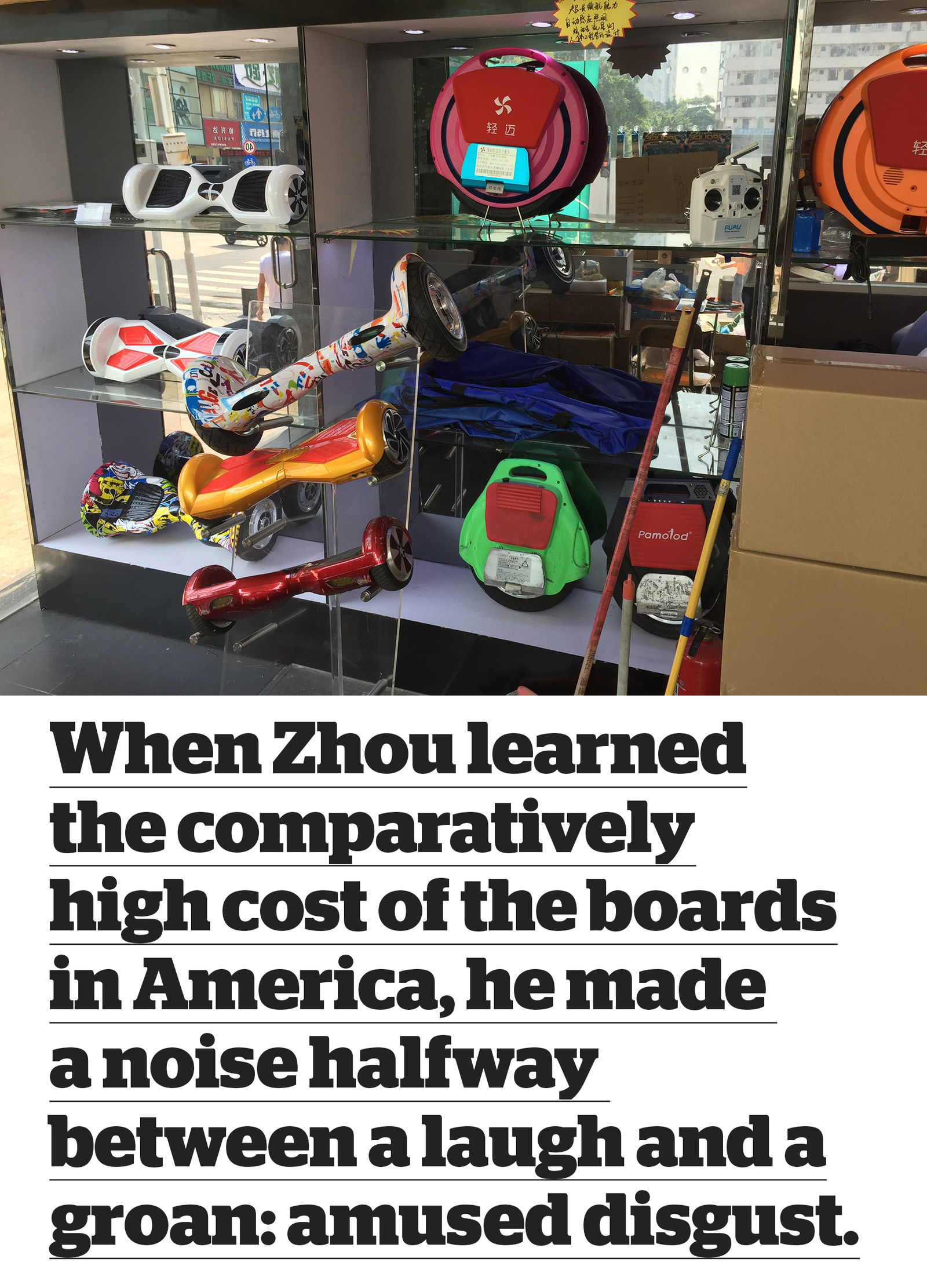
If Cool Fly didn’t work out, Zhou said, he could keep selling circuit boards to other hoverboard companies. But still, he thought this was a great opportunity. Just a year ago he had hardly heard of the things; now he was a hoverboard man.
Another great opportunity: having an American nearby so he could conduct some ad hoc market research. He asked, again and again and again, if hoverboards would stay popular. In America, a man of Zhou’s age might ask this question the same way he would ask about Doge or Soylent — a topic of amusement or possibly a minor investment. In Shenzhen the question was profound; the answer literally determined what Zhou would do with his life.
So too the lives of thousands of others. Everyone in Shenzhen knew China’s economic growth had slowed in recent years, and the manufacturing sector was no exception. Though the country’s northeastern “rust belt” had been hardest hit, electronics hadn’t been spared. Big businesses were moving their factories to cheaper Asian countries: Vietnam, Indonesia, the Philippines. In September, a major supplier for Huawei had closed its doors.
It was at times like these that Jane Chan, a twentysomething salesperson, was glad she worked on hoverboards. From the passenger seat of a taxi, as her driver sped past apartment towers wreathed in the last of the Shenzhen morning haze, Chan explained how she had ended up at ESwing, yet another hoverboard factory. Chan grew up in Jiangdezhen, a city in nearby Jiangxi province that is famous throughout the country for its porcelain ware. In English classes, she took the name “Jane” because she loved Jane Eyre. She studied civil engineering but never planned to use her degree, and at a job fair after college she was recruited to be a salesperson at an LCD manufacturer in Shenzhen. So, like thousands of other ambitious people her age, she moved south. Chan found the job at the LCD factory stressful — the industry was highly saturated and extremely competitive. Workers fretted about losing their jobs. So when she got the chance in the fall of 2014 to do a similar job at ESwing, she took it.

Several months after Chan took the new job, the LCD factory bosses laid off some of her former co-workers. Factories making products like hoverboards might not last, but they also had the flexibility to scale back or change their business entirely. And the upside seemed strong. A new product, one in high demand in the West, holds a promise that factories making older electronics do not.
“This is a totally new industry with more opportunities,” she said. “When the bosses make more money, we make more money.” At ESwing, Chan worked on a 2% commission. That meant the kind of business she solicited at places like the Hong Kong Trade Fair and Canton Fair could translate into tens or even hundreds of thousands of yuan in her pocket.
After an hour’s drive, the sedan pulled into the HanHaiDa High-Tech Industrial Park, which comprised six spotless eight-story factory buildings. They were numbered 1 to 6, with periods after each digit, as if all six buildings were sentences in a paragraph of industrial production. The park hosted all kinds of small factories, making everything from LAN cables to LED displays, like a WeWork for startup manufacturers.
In a drab conference room in building 5, Chan sat beneath a poster, a drawing of two hands, one pointing up and one pointing down, accompanied by bold text reading “Winners seek approach, Losers seek excuse.” Like Gaoke, ESwing had been around for a number of years, but moved into hoverboards when an existing client asked it to. That was in September 2014; since then, hoverboards had become half of ESwing’s business.

Compared to the aging Gaoke and the scrappy Cool Fly, the factory floor at ESwing seemed orderly, clean, and streamlined. It had air conditioning. As at the other two factories, the majority of the workers who’d come here, hundreds or thousands of miles from their hometowns, were young. Dressed in matching white ESwing T-shirts, jeans, and sneakers, the mostly male employees sat on the floor wrapping finished boards and taping up boxes for shipping. A lone laborer craned over a diagram of a finished board, which he compared at length to the real thing. Another ferried finished boards from quality control to the packaging area on a hoverboard.
The only worker on the factory floor not wearing the ESwing shirt was a young quality control tester at the end of the line. With a dreamy smile on her face and a dancer’s posture, she hopped on and checked the boards’ balance, taking each one through a series of nimble pirouettes. This made her responsible for the enjoyment and fleeting attention of thousands of people she would never meet, thousands of people who would make the social content that would drive the culture that would either keep her testing hoverboards or doing something else entirely. It was entirely possible the next viral Vine loop, the next awards show stunt, the next exasperated tweet, would start at her feet.
Behind her were stacked cardboard boxes labeled “Kaiser Baas,” the same boxes that had been at Gaoke. Perhaps Kaiser Baas buys boards from both factories. Perhaps one factory sells boards to another. Perhaps one factory sells parts to another. Perhaps both factories buy parts — or just boxes — from a third factory. (Kaiser Baas wouldn’t comment for this story.) Many such permutations exist among all the factories floating in this strange, extraordinary bubble, which people halfway around the world have the power to pop at any time.
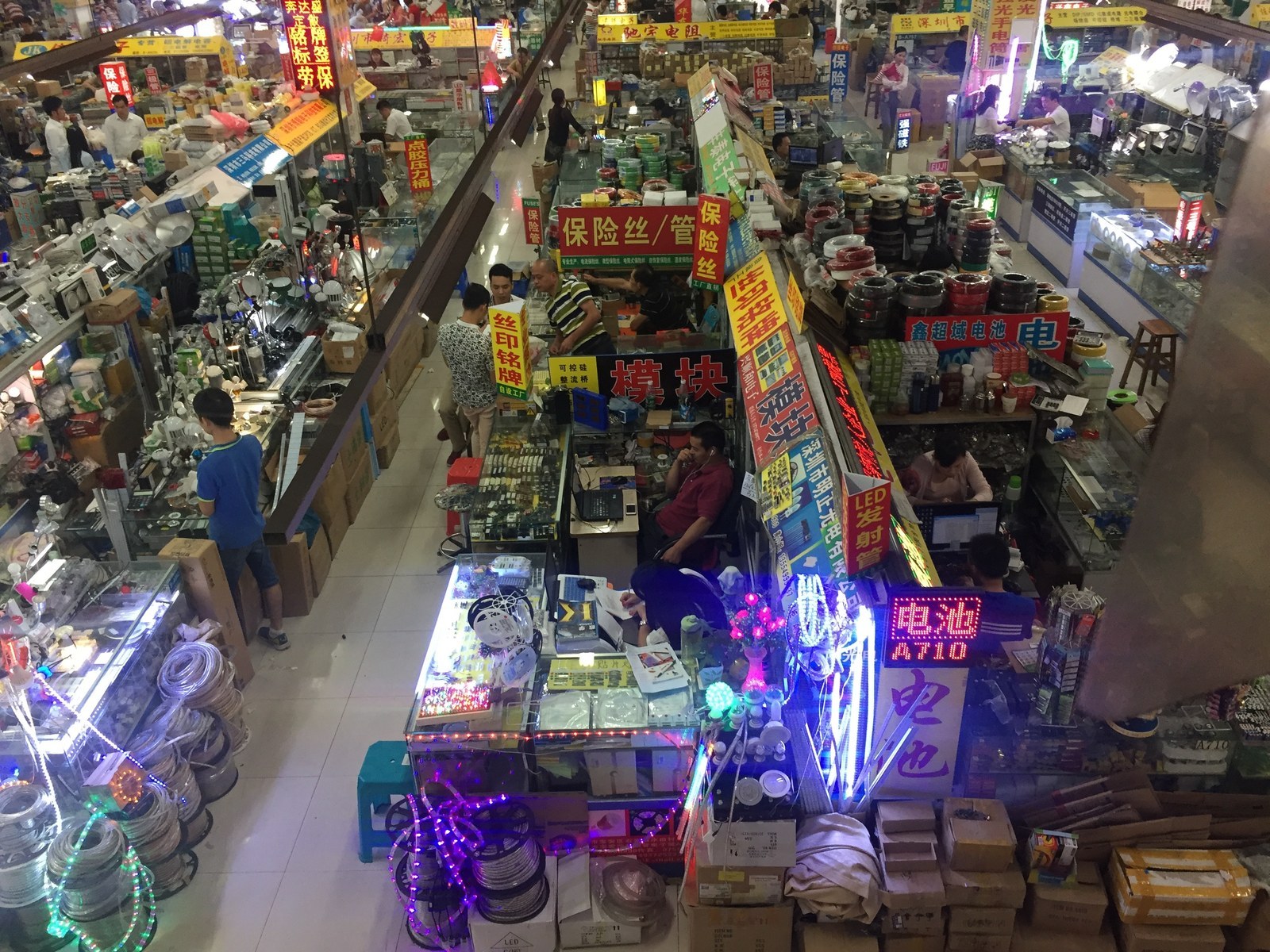
The Ladies Market is a half-mile of counterfeit goods piled high in narrow stalls that snake through Hong Kong’s teeming Mongkok district. It is the kind of place where bored peddlers use phrases like “because I like your face” and “just for you.” It makes Canal Street look like Rodeo Drive.
On a humid October night, under the glow of neon shop signs, fake Gucci purses were piled beneath fake Rolex clocks, and fake Apple Watches gleamed atop fake GoPros. Beneath every ninth or tenth stall lurked the familiar box, with the generic type reading “Smart Balance Wheel,” and an image of the bow-tie-shaped fung fo leon. The stall owners here at the Ladies Market offered the boards starting at about $1,400 HKD: $180 USD. One owner said he might sell one or two a day.
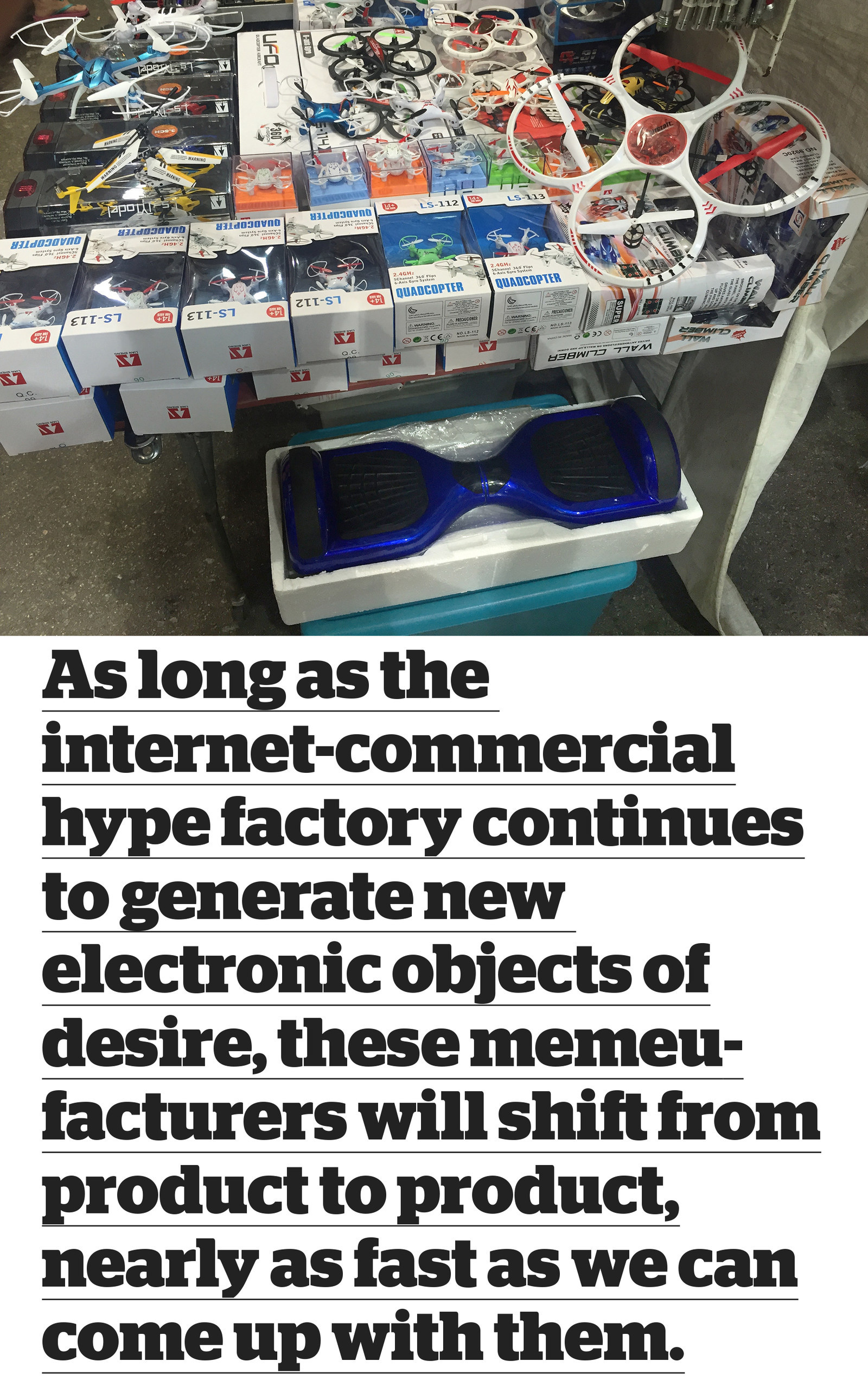
For all their hype in America, and all the feverish industry devoted to them in China, the wind-fire wheels weren’t so popular here, at least not yet. Fang Zuoyi, the Gaoke Times general manager, had said that his factory didn’t have many Chinese customers — not because people don't have the money, but because Chinese fashion is one year behind.
Fang and Zhou Changbo; Jane Chan and Rachel Yu — would any of them still be involved in the manufacture and sale of hoverboards in a year? In six months? An American toy dealer at the Hong Kong Electronics Fair had said he thought the market was already flooded and there were too many distribution issues for the boards to get even bigger in the States. Even if that wasn’t true, the patent issues in America, the boards’ largest market, might force some of the factories to change their business.
This is a sentimental question for a totally unsentimental industry. It doesn’t matter what these factories make. As long as the internet-commercial hype factory continues to generate new electronic objects of desire, these memeufactories will shift from product to product, nearly as fast as we can come up with them. And the material lives of the people within them will continue to be defined by Western whims.
Near the exit to the Ladies Market, above a blue hoverboard, on a long table piled with cheap products, danced an animatronic Minion, projecting a melody from another world. A local boy, no older than 10, wandered into the stall without pausing to look at the hoverboards. He stared at the Minion and broke into a smile.
